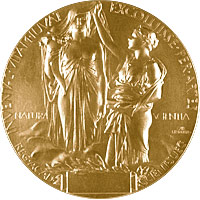Digital camera sensor inventors win the Nobel Prize in physics


Willard Boyle and George Smith (who are now 85 and 79 years old, respectively) were actually working on a picture phone for Bell Labs back in 1969, and the original CCD was meant to be a form of electronic memory rather than a device for photographic images. But by transforming light into electronic signals, the CCD allowed light to be captured electronically instead of on film, and their invention eventually revolutionized photography by forming the "electronic eye" of most digital cameras today. In fact, just a year after their initial invention, the two scientists demonstrated a CCD in use in a video camera for the first time.
Boyle and Smith actually share half the prize (getting a quarter of the $1.42 million prize each)--the other half being awarded to a scientist whose discoveries paved the way to fiber optics. Calling the three scientists "the masters of light," the Nobel jury cited the physicists' important roles in shaping modern information technology.
For detailed information and a history of both discoveries, go to the Nobel Prize in Physics 2009 website and download the Information for the Public PDF.